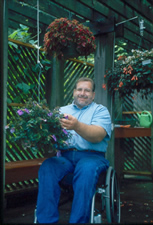 |
| Wheelchair user tending plants in low hanging baskets |
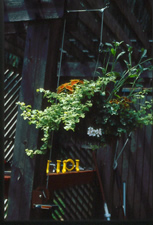 |
| Planter box with green plants attached to wooden fence |
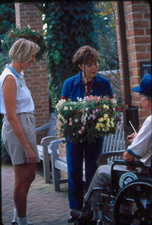 |
| Two women talking to a seated older gentleman around a pot with a colorful bouquet |
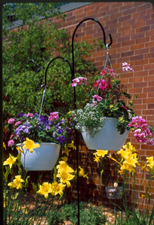 |
| Two hanging flower pots with purple, pink, and yellow flowers |
Another way to increase the amount of accessible planting space is to consider unused walls, fences, and overhangs. A trellis or netting attached to a fence or wall with planters at its base creates places to grow climbing plants. Enhanced with shelves, brackets, and hangers, unused walls, fences, decks, and balcony railings become platforms for any number of window boxes, smaller pots, baskets, and decorative containers - all within easy reach. House overhangs and shade structures over patios are among the places to use hanging baskets equipped with rope and pulley systems that allow lowering to tend, then raising out of the way.
Baskets (and bird feeders) are also easily hung at reachable heights using basket hooks, which are essentially metal rods pushed into the ground abutting paving or clamped to balcony and deck railings with an arching bend at the top to hang the basket.
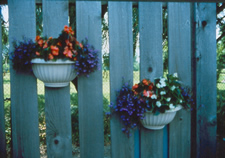 |
| Attach pots, window boxes and shelves within easy reach to sturdy fences and walls increasing the amount of accessible gardening space. |
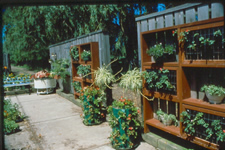 |
| Attach pots, window boxes and shelves within easy reach to sturdy fences and walls increasing the amount of accessible gardening space. |
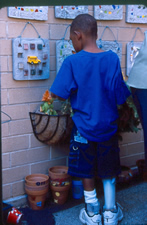 |
| A young boy with a prosthesis on his right leg watering a wire basket of orange flowers connected to a brick wall |
Worth mentioning is perhaps the ultimate in vertical gardening, a 'wall garden'. This is a custom-built wood framework made to hold an approximately 4-foot-high by 5-foot-wide, 8- to 12-inch-thick block of soil-less mix attached to a sturdy wall or fence at an accessible height. The bottom is a plank with drain holes added. The side facing towards the gardener is lined with black 4- to 6-mil plastic sheeting. The sheeting is covered and supported with a trellis frame backed with 2-inch-square galvanized wire fencing. The trellis is attached to the left or right side of the 'box' with a piano hinge along one entire side. This allows the front to be unbolted from the opposite side and swing open like a door for emptying. The top of the wall remains open for filling with soil-less planting mix blended with time-release fertilizer formulated to last the entire season as well as general watering.
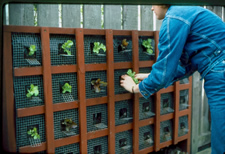 |
| A woman tending plants in a 7 by 4 square grid shelf planting system |
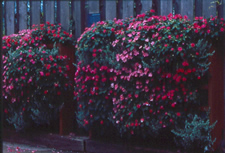 |
| Bushes planted in a wall system along a cedar fence increases the amount of accessible garden space |
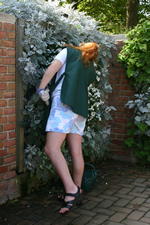 |
| A woman tends green plants on a wall system sitting between two brick columns |
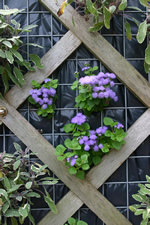 |
| Close up view of a diamond shaped cedar trellis with purple flowers and green leaves growing |
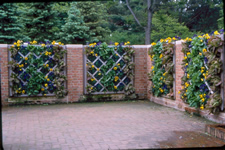 |
| Far view of a diamond shaped cedar trellis with yellow flowers and green leaves growing |
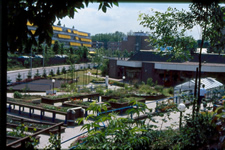 |
| View looking down on a half acre enabling garden in Europe displaying a variety of enabling garden techniques. |
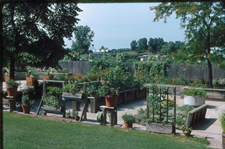 |
| Wide angled view of a demonstration enabling garden. |
Wall gardens create significant additional growing space without cluttering paved areas needed for freedom of movement. Small transplants of shallow-rooted and/or cascading varieties of vegetables, annual flowers, or herbs that normally grow no more than 12 to 15 inches tall are best. They are planted along the open top of the wall and through small holes cut through the plastic sheeting centered in each trellis opening into the soil mix inside. Plants quickly adapt to growing sideways, covering the entire wall by season end.
Wall gardens are difficult to set up and must be emptied in cold winter areas to prevent damage, but, where appropriate, make wise use of space and produce spectacular displays.
Vertical methods can significantly increase available gardening space without cluttering areas needed for freedom of movement. With consideration given to paving needs followed by the addition of larger containers, raised beds, and vertical techniques, all the elements that adapt the garden for access are now in place.
PART III of this paper can be accssed by clicking here.














